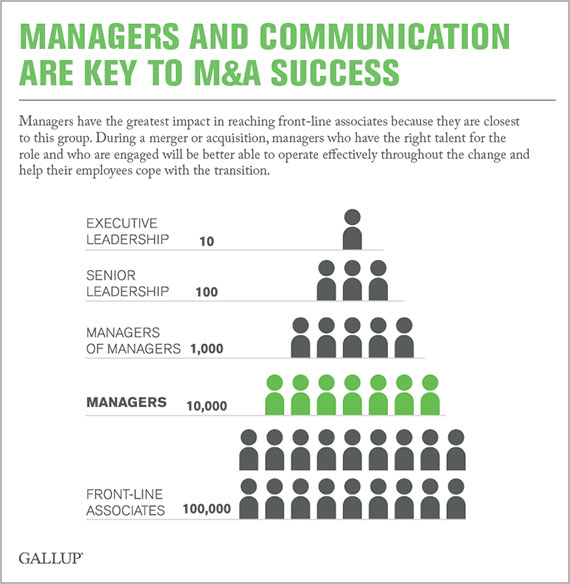Story Highlights
- Culture mismatch often causes mergers to unravel
- Frequent communication with managers and employees is key
- Don't overlook or undervalue cultural integration
Looks like the mergers & acquisition (M&A) trend in healthcare will continue its upward climb through the remainder of 2014, according to a survey conducted by Bass, Berry & Sims.
As healthcare organizations deal with the requirements of the Affordable Care Act, the increasing prevalence of population health management, and the challenges of a struggling economy, more systems are adding scale to spread costs and improve care. Many of Gallup's healthcare clients are considering acquisitions, and in the past two years, several clients have completed high-stakes, multibillion dollar deals.
Though some organizations navigate M&A successfully, many more don't. Too many mergers or acquisitions don't go according to plan or fail to achieve the expected outcomes.
Myriad factors can lead to M&A failure, but cultural mismatch is one of the most frequently cited reasons. To overcome the risk of failure, leaders must focus on understanding and developing the new entity's culture.
Through our work with clients, we've learned three strategies that can help healthcare leaders build and maintain a strong, unified culture post-M&A. By using this approach, leaders can help ensure that mergers or acquisitions go according to plan and achieve their desired results.
Strategy 1: Communicate
Leaders who communicate and interact with managers and employees regularly and often encourage culture integration and help ensure M&A success. Communication tops our list of M&A strategies because it:
- Establishes clear expectations with employees. Our experience shows that the most crucial thing managers can do to ensure success during a transition is help employees at all levels to know what's expected of them.
- Builds and strengthens relationships. When leaders reduce the distance from the C-suite to the front line, they build trust and cultivate strong relationships, which are essential components for blending cultures.
- Can increase confidence during times of uncertainty. During a transition, regular updates and a climate of transparency can foster employees' confidence in the organization's mission and long-term success, which in turn can help improve employee engagement and reduce turnover.
By creating a strong communication strategy -- and supporting the managers who are executing it -- leaders can quicken and encourage M&A success.

Strategy 2: Integrate Local Cultures
Even when merging companies' purposes are similar, their operating procedures -- or "how things get done" -- can vary dramatically. Leaders must understand how each company achieved results prior to the merger, then develop a plan for integrating these procedures and best practices. From the broad view of mission statements to the fine details of daily schedules, managers and employees in the newly formed entity must be aligned to ensure M&A success.
Recently, one health system we worked with throughout a merger prioritized developing a new, unified mission statement and communicating it to employees. Their efforts paid off: Post-merger, the health system found that a high percentage of its employees strongly agreed with the statement, "The mission or purpose of my company makes me feel my job is important." Communicating the integrated organizational mission fostered employee engagement, which in turn encouraged employees to provide a world-class patient experience.
Strategy 3: Take a Structured Approach to Managing Change
Prior to a merger or acquisition, health systems typically invest extensive time and effort to evaluate a company's assets and economic position. These dollars-and-cents factors are vitally important, but leaders should also measure and manage the crucial emotional factors that can make or break a merger. We recommend measuring employee engagement at any organization before and after M&A to:
- Develop effective strategies for integrating local culture. For example, let's say engagement studies for two merging health systems show a high percentage of the nursing team from system A strongly agree that the mission and purpose of their organization makes them feel their job is important, but far fewer of the nursing team from system B strongly agree. This difference alerts leaders that the nursing staff's managers will need to provide extra support to integrate and align these teams with the new entity's mission.
- Improve organizational outcomes. In our work with M&A, we've found that employee engagement and leadership talent data create an invaluable compass post-merger, especially during the crucial first 90 days. Employee engagement survey results give managers and their teams opportunities to discuss the elements that are key to the teams' success and shine a spotlight on any barriers to achieving team goals. Armed with data reflecting the current engagement climate of the new entity, leaders can see which strategies are working and where changes need to be made, which helps foster unity, build momentum and encourage organizational growth. By making an organizational commitment to measuring employee engagement regularly following a merger or acquisition, healthcare leaders can monitor the key elements that lead to increased productivity, profitability and employee retention.
- Set organizational goals. Our experience is that sharing goals and maintaining accountability with specific benchmarks can help healthcare organizations improve key outcomes, such as patient satisfaction scores, employee onboarding time and medical supply availability. After reviewing employee engagement data, leaders and managers can set clear priorities, establish expectations with employees and create benchmarks on the path to goal achievement.
Building an Engaged Work Culture Matters Too
Integrating different cultures is just as key to ensuring M&A success as integrating the organizations' financials. We strongly advise healthcare leaders to avoid overlooking or undervaluing the power of cultural integration in M&A. When leaders are dedicated to building an engaged work culture -- and demonstrate that commitment with strong communication, a cultural focus and by measuring employee engagement -- they are optimally positioned for success in M&A.

